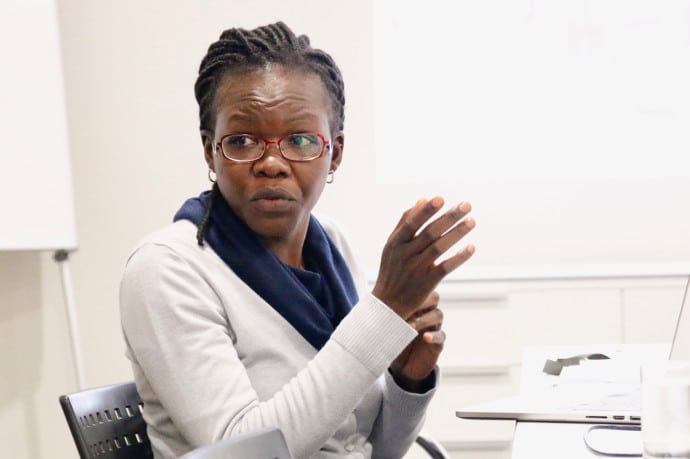“Over 45% of people in Africa do not have access to clean drinking water. This number is rising due to unequal distribution of water sources, climate change impacts, rapid population growth and increasing pollution. In order to meet the United Nations Sustainable Development Goals on health (3) clean water (6) and sustainable cities (11), there is an urgent need to take stock of the trends in water quality.”

“Water sources like rivers and lakes are transboundary so regional co-operation is vitally important.”
This is the opinion of STIAS fellow Lydia Olaka of the Department of Geology at the University of Nairobi. Olaka is undertaking a study of water quality and the existence of regulations and guidelines in seven African cities, and presented her initial findings to STIAS fellows.
“Urban, industrial and agricultural sectors have introduced over 60 000 chemicals that end up in water. Toxins such as heavy metals, nutrients, pesticides and pharmaceuticals with serious impacts on ecosystems and human health. Research has highlighted the detrimental impacts of these pollutants on animals especially fish, birds and frogs. The increase in non-communicable diseases, such as cancers, cardiovascular and neurological conditions, and birth defects has also been linked to increased toxins in our environment. This project seeks to assess the levels and risks of emerging contaminants in the urban water supply for seven cities (Nairobi, Kampala, Dar es Salaam, Lusaka, Lilongwe, Harare and Cape Town) in East and Southern Africa. I’m also reviewing the existing policy guidelines and regulations on drinking water quality standards and freshwater protection to identify gaps and suggest remediation and protection options.”
“Water is a very important issue,” she continued. “Many countries in Africa are facing severe water stress. Cape Town only just avoided Day Zero this year so the water issue is at the forefront. But it’s not just about quantity we also need to look at the quality of the available fresh water. There is less freshwater available and the quality is declining.”
Olaka focused on three countries – Kenya, Zimbabwe and South Africa – for the purposes of her presentation.
“In addition to increased agricultural and industrial chemicals and toxins, the rapidly growing informal settlements without proper sanitation and sewerage infrastructure in the urban areas, further contaminate the water sources with sewage.”
She pointed to emerging contaminants including pesticides (herbicides, fungicides and insecticides), pharmaceuticals, flame retardants, cosmetics and industrial chemicals.
“Despite many of these chemicals being harmful to health, only a handful are regulated and there are no guidelines and limits set in many of the countries including Kenya. The Water Master Plan for 2030 doesn’t mention pesticides and pharmaceuticals.”
“Similarly in Zimbabwe, there are no set standards for drinking water thresholds and no mention in the National Water Plan.”
“In South Africa there are more data available and a lot more studies have been done on the health effects of contaminated water. The South African Department of Water Affairs does have guidelines in place and water is regularly checked particularly for majority of the pesticides.”
“Traditionally in Africa people didn’t use pesticides because they were too expensive,” she continued. “Now many governments are subsidising their use to increase food production and food security. This means there is increased use without necessarily proper information on how much to use and how to dispose of these substances safely. Such use is often not fully documented.”
“We know that there are links to health effects like cancers, birth defects, asthma and reduced fertility. This affects both humans and also animals and, in some cases, is transgenerational.”
“We have to encourage the development and use of less-toxic alternatives.”
In discussion, Olaka also addressed the issue of pesticides that are banned in some countries still being sold and used in African countries to sustain global markets.
“There is a need to combine education and proper legislation within countries and across the region,” she said.
Olaka’s preliminary findings show a big gap in knowledge, lack of regulatory guidelines in some countries and no systematic monitoring. She highlights an urgent need for collaboration between government departments like agriculture, water and health as well as a need for comprehensive national surveys in the region and for regional bodies to connect and foster collaboration between countries in regard to water quality.
“We need baseline data from countries in the region to be able to monitor the changes over time and their impact.”
Olaka pointed out that there is probably already a reasonable possibility of co-operation in East and Southern Africa due to the existence of the East Africa Community which links Burundi, Kenya, Rwanda, South Sudan, Tanzania and Uganda, and the Southern African Development Community (SADC) which aims to further socio-economic co-operation as well as political and security co-operation among 16 southern African states. However, she highlighted that there is a need for more evidence and data to ensure that the water quality issue is on the agendas of these bodies.
“The SDG goals are supposed to be achieved by 2030 – access to clean water is a major issue in itself but also substantially affects many of the other goals – and will not be achieved in Africa unless we act soon.”
Michelle Galloway: Part-time media officer at STIAS
Photograph: Christoff Pauw
